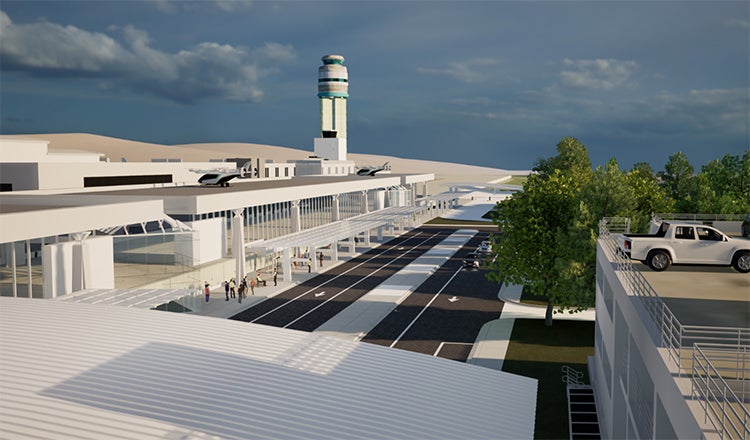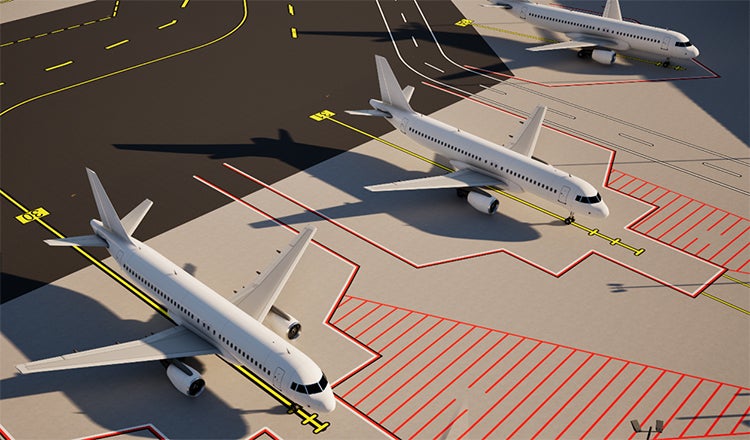Embracing Visualization: A Transformative Approach for Airport Infrastructure Projects
Advancements in 3D visualization technology have revolutionized our ability to envision, design and implement infrastructure projects. This capability is showing its value on airport infrastructure projects, where conveying design intent accurately and effectively is paramount. These realistic views and dynamic options not only enhance understanding but also streamline decision-making processes, ultimately saving valuable time and resources.
Proven Success in Airport Projects
Our teams are already actively benefiting from advanced visualization techniques on airport projects. From terminal projects to landside traffic realignments and airfield upgrades, these visualization services are empowering clients with dynamic tools that go beyond static documents. Designs can be brought to life through animations, realistic visualizations, even virtual reality environments. These immersive experiences allow decision-makers to explore and understand designs more effectively, resulting in more efficient project execution.
Addressing Challenges: Is Visualization Difficult and Expensive?
A common misconception about advanced visualization is that it is both difficult and expensive. However, with the state of technology continually advancing, high quality visuals can be generated much more quickly than just a few years ago, even for smaller projects. Creating these visual scenes can be done in days, not weeks or months. The data needed is often already gathered as part of the design process or available from outside vendors. Converting designs to lifelike 3D representations is then achieved by experienced modelers using a number of advanced software packages.
Given the speed at which experienced modelers can complete their work, visualizations are not prohibitively expensive and can be implemented efficiently and affordably. The low threshold means project teams can use these tools throughout the design stages, allowing for checks and validations at different completion levels. This iterative process helps improve design efficiency and accuracy. As visualization has become more accessible and cost-effective, it also means that it can be applied to smaller projects, such as visualizing crosswalks or pedestrian paths at intersections.

How Does Visualization Work?
At the core of this process are modelers who specialize in creating 3D representations. These professionals can transform flat images, such as those from Google Earth, into detailed three-dimensional models. These models include buildings, trees and any other above-ground infrastructure. The models are then populated with elements such as people, cars and other real-world objects to create a realistic representation of the project.
The scenes are rendered using advanced software, often derived from gaming technology, to produce realistic visuals. It provides clients with a lifelike example of how the proposed designs will interact with the existing environment. The final output could be a video of a specific project piece. Or it could be a 3D environment that users can interact with via their computer or a headset to better understand the proposed design solution and visualize operational impacts during construction.
The Benefits of Visualization: Bridging Understanding
Traditional engineering designs, often presented in PDFs or static images of construction plans, can be difficult to interpret without extra explanation or time. This can lead to confusion or misinterpretation, requiring redesign or extra discussion. 3D visualizations bridge this gap by providing clear, interactive representations of projects.
By providing interactive visualizations, all members of a project team can see exactly how the designs will impact the real world, including accurate airfield and landside traffic patterns, pedestrian flow and overall infrastructure interaction. The technology can also be used for sunlight/shadow studies, obstruction analysis and exploration of construction phasing impacts. With visualizations incorporated early in the design stages, airport owners and other stakeholders can provide more informed feedback, reducing the need for extensive revisions and saving time.
The ability to show design iterations in real time also promotes a better understanding of how design changes interact with each other. A project with multiple design changes dependent on each other can produce multiple variations. Using real time visualization tools allows users to explore the various design change options interactively to improve awareness of the impacts of design decisions.

Applicability Across Projects
While visualization services are beneficial for all types of projects, they are particularly valuable for landside and airside projects at airports. On the landside, where traffic complexity is high, 3D models can illustrate how roadways will service the airport, showing construction phasing and changes in traffic conditions over time. This clarity is crucial for effective planning and minimizing disruptions. Visualizations can be particularly helpful in communicating design intent and impacts to non-technical stakeholders, including operations, public safety, traffic management staff, off-site shuttle and TNC operators and more.
On the airside, visualization tools help in planning runway/taxiway alternative analysis designs, aircraft parking and other critical infrastructure. By simulating aircraft movements and interactions, these tools provide a clearer understanding of how different aircraft types will fit and operate within the space. This is a significant improvement over traditional 2D plans, which can be challenging to interpret accurately.
Streamlined Decisions, Better Understanding
The integration of advanced visualization services in airport infrastructure projects is not just a novel idea but a proven and effective approach to achieve a deeper understanding of design intent, streamline decision-making processes and ultimately deliver more successful projects. This shift towards visualization is driven by engineers who recognize the need for more interactive and realistic representations of designs and to communicate with non-technical stakeholders more effectively. As technology continues to advance, the adoption of these services will become increasingly essential in delivering efficient and effective infrastructure solutions.




